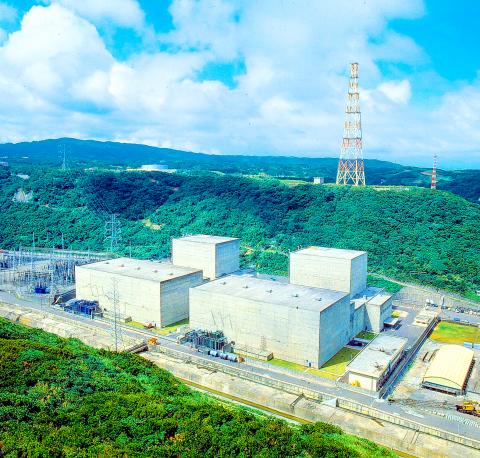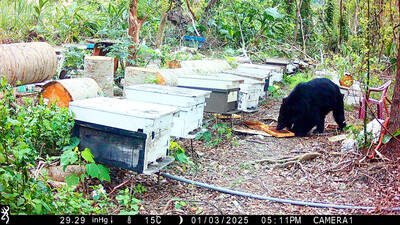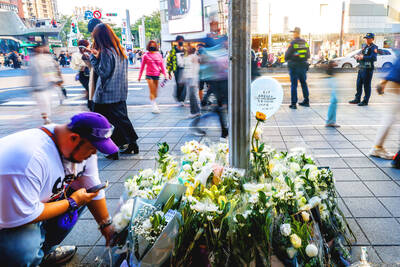The Atomic Energy Council (AEC) yesterday issued a permit to state-run Taiwan Power Co (Taipower) to decommission the Jinshan Nuclear Power Plant over a 25-year period, council official Kao Pin (高斌) said, adding that storage of used fuel rods remains a major challenge.
Built in New Taipei City’s Shihmen District (石門) in the 1970s, Taiwan’s first nuclear power plant, it has two reactors with an installed capacity of 636 megawatts each, information on Taipower’s Web site showed.
The 40-year operation permit for the plant’s No. 1 reactor expired on Dec. 5 last year, but it has not operated since 2014 due to a problem with reactor components, Kao said.

Photo courtesy of Taiwan Power Co
The 40-year permit for its No. 2 reactor is to expire on Monday, although it, too, has not been in operation since a power transmission tower collapsed due to heavy rain in June 2017, he said.
After Taipower’s decommissioning plan last week obtained environmental impact assessment approval from the Environmental Protection Administration (EPA), the council yesterday issued the permit, which is to take effect on Tuesday, he said.
The utility is required to finish decommissioning the plant within 25 years, while its priority is to remove 816 used fuel rods from the two reactors, he said.
The plant’s two pools for spent fuel rods have a capacity of 3,083 fuel rods each and currently contain 3,074 and 3,076 rods from the two reactors, he said.
Although the utility has built a dry-storage site for spent rods, the New Taipei City Government has been reluctant to issue a water and soil conservation permit for it, one of the sticking points in the EIA process.
Taipower has to obtain the water and soil conservation permit, otherwise it would not be able to remove the fuel rods from the reactors, Kao said.
Operating permits for the two reactors at the Guosheng Nuclear Power Plant in New Taipei City’s Wanli District (萬里) are to expire on Dec. 27, 2021, and March 14, 2023.
The utility’s proposal for decommissioning the Guosheng plant’s reactors is being reviewed by the council and the EPA, Kao said.
The nation’s nuclear energy is generated by four reactors at the Guosheng plant and the Ma-anshan Nuclear Power Plant in Pingtung County, making up about 11.6 percent of the national total, Taipower’s Web site showed.

SHIPS, TRAINS AND AUTOMOBILES: The ministry has announced changes to varied transportation industries taking effect soon, with a number of effects for passengers Beginning next month, the post office is canceling signature upon delivery and written inquiry services for international registered small packets in accordance with the new policy of the Universal Postal Union, the Ministry of Transportation and Communications said yesterday. The new policy does not apply to packets that are to be delivered to China, the ministry said. Senders of international registered small packets would receive a NT$10 rebate on postage if the packets are sent from Jan. 1 to March 31, it added. The ministry said that three other policies are also scheduled to take effect next month. International cruise ship operators

NUMBERS IMBALANCE: More than 4 million Taiwanese have visited China this year, while only about half a million Chinese have visited here Beijing has yet to respond to Taiwan’s requests for negotiation over matters related to the recovery of cross-strait tourism, the Tourism Administration said yesterday. Taiwan’s tourism authority issued the statement after Chinese-language daily the China Times reported yesterday that the government’s policy of banning group tours to China does not stop Taiwanese from visiting the country. As of October, more than 4.2 million had traveled to China this year, exceeding last year. Beijing estimated the number of Taiwanese tourists in China could reach 4.5 million this year. By contrast, only 500,000 Chinese tourists are expected in Taiwan, the report said. The report

The Forestry and Nature Conservation Agency yesterday launched a gift box to market honey “certified by a Formosan black bear” in appreciation of a beekeeper’s amicable interaction with a honey-thieving bear. Beekeeper Chih Ming-chen (池明鎮) in January inspected his bee farm in Hualien County’s Jhuosi Township (卓溪) and found that more than 20 beehives had been destroyed and many hives were eaten, with bear droppings and paw prints near the destroyed hives, the agency said. Chih returned to the farm to move the remaining beehives away that evening when he encountered a Formosan black bear only 20m away, the agency said. The bear

HORROR STORIES: One victim recounted not realizing they had been stabbed and seeing people bleeding, while another recalled breaking down in tears after fleeing A man on Friday died after he tried to fight the knife-wielding suspect who went on a stabbing spree near two of Taipei’s busiest metro stations, Taipei Mayor Chiang Wan-an (蔣萬安) said. The 57-year-old man, identified by his family name, Yu (余), encountered the suspect at Exit M7 of Taipei Main Station and immediately tried to stop him, but was fatally wounded and later died, Chiang said, calling the incident “heartbreaking.” Yu’s family would receive at least NT$5 million (US$158,584) in compensation through the Taipei Rapid Transit Corp’s (TRTC) insurance coverage, he said after convening an emergency security response meeting yesterday morning. National